Latest episode
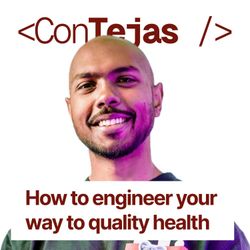
How to Engineer Your Way to Quality Health
01:52:55|Links- Codecrafters: https://tej.as/codecrafters- Why We Sleep: https://www.amazon.de/-/en/Why-We-Sleep-Unlocking-Dreams/dp/1501144316- Matthew Walker's Podcast: https://open.spotify.com/show/1aIVAabjRjnmiouX0zCzF3- Sleep latency paper: https://pubmed.ncbi.nlm.nih.gov/33865376/#:~:text=Oral%20magnesium%20supplementation%20for%20insomnia,insomnia%20symptoms%20in%20older%20adults- Glycine for sleep: https://glowable.com.au/blogs/news/glycine-the-calming-nutrient-for-soothing-anxiety?srsltid=AfmBOor_YWMUUsqdS9AJjfSJLQb1F0CSEKrbw-0AhjCVkXCcHdjPGtWq#:~:text=of%20Pharmacological%20Sciences%20found%20that,often%20closely%20linked%20to%20anxiety- Dr. Andy Galpin's podcast: https://performpodcast.com/- Detachment paper: https://pubmed.ncbi.nlm.nih.gov/19592515/#:~:text=Results%3A%20%20Higher%20PEAT%20scores,of%20depression%20and%20negative%20affect- Quantified Scientist: https://www.youtube.com/c/TheQuantifiedScientistIn this episode, we learn how to engineer better health outcomes for ourselves to live fitter and healthier than ever before drawing on the latest research.Chapters00:00:00 Intro00:05:24 Episode Outline00:12:08 Sleep Architecture: Deep and REM00:24:17 How to Sleep Well00:34:31 My Routine with Sleep00:39:25 Using Temperature to Sleep Well00:41:55 Eating before Bed00:45:14 Getting more Deep Sleep and REM Sleep00:52:49 How to Eat Well00:56:05 How to Lose Fat01:02:35 How to Gain Muscle01:07:47 Vices: Alcohol, Nicotine, etc.01:10:28 Loneliness and Social Connection01:18:34 How to Develop Quality Social Connections01:25:54 Maximizing Productivity and Work/Life Balance01:33:36 Psychological Detachment01:36:33 Dealing with Getting Sick01:42:08 How to Avoid Jetlag and Travel Well01:46:14 Heart Rate Variability: Managing Stress and Recovery01:50:53 Conclusion
More episodes
View all episodes

Pratim Bhosale: How to get into AI from Backend Engineering
01:32:26|Links- CodeCrafters (partner): https://tej.as/CodeCrafters- Pratim on X: https://x.com/bhosalepratim- Tejas on X: https://x.com/tejaskumar_SummaryIn this conversation, we explore the journey from backend development to becoming a Google Developer Expert in Golang. We discuss the significance of microservices architecture, the importance of search technologies, and the development of Cargo Chat, a tool for searching codebases. Pratim shares insights on building effective search pipelines, Matryoshka embedding models, and the integration of hypothetical documents in search processes. The conversation concludes with a discussion on a mental health journaling app that connects personal reflections with religious texts for encouragement. Chapters00:00 Pratim Bhosale02:19 Introduction05:16 The Shift to Backend Development and Golang08:16 Becoming a Google Developer Expert11:20 Understanding Microservices Architecture14:19 Building Innovative Tools: Cargo Chat17:12 Search Technologies and Their Applications20:15 The Search Pipeline and Embedding Models29:49 Building a Vector Database33:13 Local First Movement and Security34:14 Understanding Hyde: Hypothetical Document Embeddings36:48 Matryoshka Embedding Models41:59 The Search Problem in AI43:57 Developing a Mental Health App48:02 Comparing Approaches to Vector Search52:56 Developer Experience and Product Growth01:02:52 Understanding Developer Experience Levers01:04:32 Making API Products Click01:07:40 The Role of Developer Advocacy01:11:06 Navigating Career Paths in Tech01:13:58 Finding Your Niche in Developer Relations01:20:18 Work-Life Balance and Avoiding Burnout01:24:01 The Importance of Mentorship01:27:07 Emerging Technologies and Trends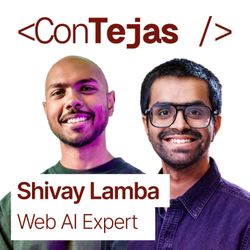
Shivay Lamba: How to run secure AI anywhere with WebAssembly
01:33:49|Links- CodeCrafters (partner): https://tej.as/codecrafters- WebAssembly on Kubernetes: https://www.cncf.io/blog/2024/03/12/webassembly-on-kubernetes-from-containers-to-wasm-part-01/- Shivay on X: https://x.com/howdevelop- Tejas on X: https://x.com/tejaskumar_SummaryIn this podcast episode, Shivay Lamba and I discuss the integration of WebAssembly with AI and machine learning, exploring its implications for developers. We dive into the benefits of running machine learning models in the browser, the significance of edge computing, and the performance advantages of WebAssembly over traditional serverless architectures. The conversation also touches on emerging hardware solutions for AI inference and the importance of accessibility in software development. Shivay shares insights on how developers can leverage these technologies to build efficient and privacy-focused applications.Chapters00:00 Shivay Lamba03:02 Introduction and Background06:02 WebAssembly and AI Integration08:47 Machine Learning on the Edge11:43 Privacy and Data Security in AI15:00 Quantization and Model Optimization17:52 Tools for Running AI Models in the Browser32:13 Understanding TensorFlow.js and Its Architecture37:58 Custom Operations and Model Compatibility41:56 Overcoming Limitations in JavaScript ML Workloads46:00 Demos and Practical Applications of TensorFlow.js54:22 Server-Side AI Inference with WebAssembly01:02:42 Building AI Inference APIs with WebAssembly01:04:39 WebAssembly and Machine Learning Inference01:10:56 Summarizing the Benefits of WebAssembly for Developers01:15:43 Learning Curve for Developers in Machine Learning01:21:10 Hardware Considerations for WebAssembly and AI01:27:35 Comparing Inference Speeds of AI Models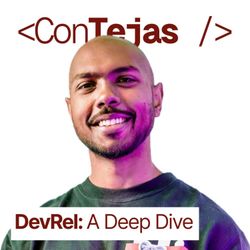
DevRel deep dive: what it is, how to do it, how to measure it
02:06:49|Links- Codecrafters (Partner): https://tej.as/codecrafters- Tejas on X: https://x.com/tejaskumar_- Mary Thengvall, The Business Value of Developer Relations: https://develocity.io/measuring-devrel-success-effective-metrics-for-impact/#:~:text=In%20a%20talk%20given%20at,5- Matthew Revell, “What is Developer Relations?”: https://developerrelations.com/guides/what-is-developer-relations/#:~:text=Most%20companies%20invest%20in%20DevRel,because%20they%20want%20to%20affect- Quinton Wall, Does Developer Relations Belong Under Marketing or Engineering?: https://www.linkedin.com/pulse/does-developer-relations-belong-under-marketing-engineering-wall-z9gic#:~:text=For%20early%20stage%20companies%2C%20Developer,the%20detriment%20of%20developer%20experience- Mike Stowe, A Brief History Of Developer Relations Programs: https://influitive.com/blog/brief-history-developer-relations-programs-developer-communities/#:~:text=When%20I%20joined%20Constant%20Contact,across%20one%20of%20these%20companies- R. Scott, Developer Relations: A Growth Engine from Day One: https://www.delltechnologiescapital.com/resources/devrel-day-one#:~:text=%E2%80%8DDeveloper%20Relations%20is%20at%20its,%E2%80%9D- Matt Bernier, The intersection of DevRel and Product Management: https://developerrelations.com/talks/intersection-dev-rel-product-management/#:~:text=The%20Barbican%2C%20London%2C%20UK- Develocity.io, Measuring DevRel Success: Effective Metrics for Impact: https://develocity.io/measuring-devrel-success-effective-metrics-for-impact/#:~:text=impact%20on%20user%20engagement%20and,2- Jake Prins, 10 Ways to Build a Developer Community: https://www.apideck.com/blog/ten-ways-to-build-a-developer-community#:~:text=in,seminar%2C%20or%20webinar- Francine Hardaway, DevRel: Marketing, Product Management, or Neither?: https://medium.com/influence-marketing-council/devrel-marketing-product-management-or-neither-77d6c4666f7f#:~:text=Most%20developer%20relations%20programs%20wrestle,sourced%20by%20DevRel%20are%20invaluableChapters00:00:00 Introduction00:02:28 The Core Thesis of DevRel00:12:41 History of DevRel: From Apple in the 80s to Today00:19:08 The Value of DevRel & Success Stories (Stripe, MongoDB)00:25:08 The Critical Role of the Feedback Loop00:27:03 The Danger of Ignoring DevRel Feedback00:34:33 Where DevRel Sits: Marketing vs. Product & Engineering00:37:22 The Gold Standard: A Product Engineer with a Megaphone00:49:37 Measuring DevRel Success: Beyond Vanity Metrics00:52:00 Key Metrics: Community, Satisfaction, & Monthly Active Developers (MAD)01:01:31 Practical DevRel: How to Build Community01:03:37 Practical DevRel: Content Strategy & "Carving the Turkey"01:06:50 Practical DevRel: Improving the Onboarding Experience01:11:00 Practical DevRel: Events, Public Speaking & Internal Advocacy01:17:20 Start of Q&A with Africa's DevRel Community01:18:02 Defining AI Engineering vs. Machine Learning01:20:01 Defining DevRel: It's High-Quality Customer Relations01:26:32 Q&A: Is Developer Experience (DX) the same as User Experience (UX)?01:29:14 Q&A: How AI is Changing UX/DX with Model Context Protocol (MCP)01:35:32 Q&A: Biggest Opportunities for DevRel in AI01:38:25 Q&A: Necessary Skills for AI DevRel (Communication is #1)01:44:22 Q&A: Where to Find Developers for New Niche Tools01:48:08 Q&A: What's Most Exciting in Tech Right Now?01:53:22 Q&A: Advice for New Developers in the AI Era (Build and Ship!)01:58:00 Q&A: How to Balance Technical Work with Community Management02:00:57 Q&A: How to Form Meaningful Professional Relationships02:05:56 Conclusion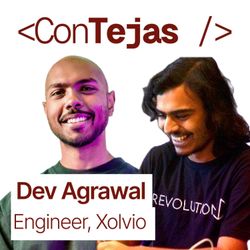
Dev Agrawal: How to be notable, event sourcing, and SolidJS
01:46:11|Links- CodeCrafters (partner): https://tej.as/codecrafters- Dev on X: https://x.com/devagrawal09- Xolvio: https://xolv.io/- Tejas on X: https://x.com/tejaskumar_Previous Episodes- Taylor Desseyn - YouTube: https://www.youtube.com/watch?v=6l6GpkHNlZw - Spotify: https://open.spotify.com/episode/1xN7YeNpkCf4qJ3kUkVVuh - Apple: https://podcasts.apple.com/nz/podcast/taylor-desseyn-how-to-build-a-genuine-high-quality-network/id1731855333?i=1000684664112- Event Sourcing - YouTube: https://www.youtube.com/watch?v=VtmPTigdpos - Spotify: https://open.spotify.com/episode/32dmiUBZclkXNWT1YcUJHr - Apple: https://podcasts.apple.com/us/podcast/event-sourced-architecture-a-deep-dive/id1731855333?i=1000696976876SummaryWe discuss the journey of becoming a notable developer, the importance of intentional networking, and the role of content creation in building a professional presence. Dev shares insights from his experiences in DevRel, the challenges of the industry, and the significance of event sourcing in modern applications.We then discuss the intricacies of event sourcing, exploring its implications for software architecture, performance, and testing. The discussion highlights the importance of projections, caching, and the separation of command and query responsibilities (CQRS) in building efficient applications. Real-world applications, such as Git and Redux, are examined as examples of event sourcing in practice.Finally, we explore Solid.js and its comparison with React, focusing on fine-grained reactivity, the challenges of adopting new frameworks, and the evolution of web development practices. They explore the unique features of Solid.js, including its compiler and async signals, while discussing the broader implications for developers transitioning between frameworks. The conversation also touches on the importance of full stack development and the mindset required to excel in the field.Chapters00:00:00 Dev Agrawal00:04:16 Becoming Notable in Tech00:14:24 Intentional Networking and Building a Presence00:24:27 The Role of Content Creation00:34:29 DevRel Insights and Career Transitions00:44:05 Understanding Event Sourcing00:43:37 Caching and Performance in Event Sourcing00:48:42 Real-World Applications of Event Sourcing00:51:31 Command Query Responsibility Segregation (CQRS) Explained00:54:24 Event Sourcing in UI State Management00:57:25 Overcoming Resistance to Event Sourcing01:00:22 The Challenges of Transitioning to Event Sourcing01:04:34 Storing Events and Schema Management01:07:16 Testing with Event Sourcing01:08:51 Introduction to Solid.js and Its Advantages01:13:12 Understanding Fine-Grained Reactivity01:15:06 Challenges in Replacing React01:16:30 The Unique Model of Solid.js01:18:22 The Catch-22 of Learning React01:19:52 Comparing Fine-Grained Reactivity in Solid and React01:23:50 The Role of Solid's Compiler01:25:57 Exploring Solid.js 2.0 and Async Signals01:28:55 Server-Side Rendering and Async Signals01:35:08 Partial Pre-Rendering and Edge Workers01:37:41 Becoming a Full Stack Developer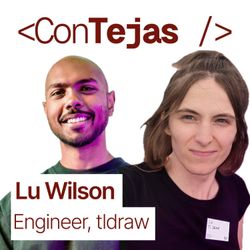
Lu Wilson: How to Build an AI-Native Whiteboard for Everyone
01:09:13|Links- CodeCrafters (partner): https://tej.as/codecrafters- Lu on X: https://x.com/todepond- Lu on Bluesky: https://bsky.app/profile/todepond.com- Lu on YouTube: https://www.youtube.com/@todepond- tldraw: https://tldraw.com/- Make Real: https://makereal.tldraw.com/- tldraw computer: https://computer.tldraw.com/- Tejas on X: https://x.com/tejaskumar_SummaryWe talk with Lu Wilson, an engineer at tldraw: a startup focused on innovative whiteboard technology. Together, we discuss the evolution of tldraw, the impact of AI on creative workflows, and the importance of experimentation in tech development. Lu shares insights on their very interesting experiments like Make Real and the new tldraw Computer, emphasizing the need for user-friendly AI tools that empower everyone, not just programmers. The discussion also touches on building a culture of experimentation within teams and the future of AI in design and development.Chapters00:00 Lu Wilson04:12 Introduction to TL Draw and Lou Wilson's Work07:12 Exploring Make Real: AI and Canvas Integration10:07 The Evolution of TL Draw Computer12:56 User Experiences and Creative Applications15:57 Future Directions and Innovations in TL Draw19:06 AI Workflows: Democratizing Technology for Everyone35:16 The Evolution of Teal Draw's Features38:05 Challenges in Implementing Autocomplete41:23 Building a Future-Proof AI Module43:01 Understanding LLMs and Canvas Interaction45:52 Evaluating AI Performance on Canvas48:25 AI as a Collaborative Partner53:01 Fostering a Culture of Experimentation54:11 Balancing Innovation and Business Goals
Sean Roberts: How to create better UX with AI Agent Experience (AX)
01:51:19|Links- Codecrafters (sponsor): https://tej.as/codecrafters- Agent Experience: https://agentexperience.ax- Arrazo: https://spec.openapis.org/arazzo/latest.html- Netlify: https://netlify.com- Sean on X: https://x.com/JavaSquip- Tejas on X: https://x.com/tejaskumar_SummaryThis episode dives deep into the emerging field of Agent Experience (AX), exploring how software agents, including LLMs, will interact with the web and online services. The conversation highlights the distinction between the "human web" and the "agent web," emphasizing the need for new approaches to ensure agents can effectively understand context and execute tasks.Key topics include contextual alignment protocols like MCP (Machine Context Protocol), and standards such as `llms.txt` and `agents.json`, alongside efforts like Arrazo, which aim to provide structured information and enable complex workflows for agents. A significant portion of the discussion focuses on the challenges of authentication for agents, moving beyond human-in-the-loop processes and complex systems like OAuth2 towards more agent-friendly, secure, and auditable solutions, possibly involving dedicated agent user identities.The dialogue also covers practical considerations like providing data to LLMs efficiently, the importance of API accessibility for agents, and the need for businesses to adapt to this new paradigm of interaction. Finally, the conversation underscores that AX is a rapidly evolving area, transitioning from theoretical concepts to practical applications, with a strong call for community collaboration to develop best practices and robust solutions for the future of agent-driven web interactions.Chapters00:00 Intro03:35 Exploring Agent Experience (AX) and Its Importance06:23 Understanding the Role of Model Context Protocol (MCP)09:22 The Principles of Great Agent Experience12:24 Agent Accessibility and Its Challenges15:34 Contextual Alignment: Enhancing Agent Interaction18:31 Human-Centric Design in Agent Experience21:23 The Future of AI and Agent Experiences24:25 Improving Human Accessibility Through Agentic Experiences27:29 Primitives of Agent Accessibility30:22 Avoiding Human in the Loop Patterns33:19 Authentication in an Agentic World38:34 Navigating API Token Strategies43:30 Contextual Alignment: The Next Frontier55:50 Understanding Agents vs. Bots01:00:19 Optimizing Contextual Alignment for Agents01:14:11 Understanding Website Infrastructure and Cost Implications01:14:37 The Role of LLMs in Web Navigation01:17:54 Quantifying ROI in Web Technologies01:19:43 Introduction to Arazo and Workflow Management01:24:26 Measuring Human vs. Agent Interaction01:30:28 The Emergence of Agent Experience (AX)01:38:09 Five Principles of Agent Experience (AX)
